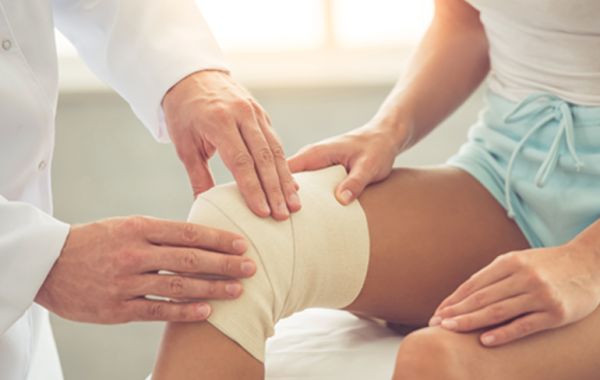Anterior cruciate ligament (ACL) reconstruction...as good as it is, it is still not perfect. ACL reconstruction is one of the most successful procedures we have in orthopaedics, that is, depending on the type of patient...
Surgeons will inform patients that there is about a 85-90% success rate of ACL reconstruction, and we're not lying. This means that a HUGE percentage of people who undergo an ACL reconstruction are happy with the outcome and able to return to the same level of activity they participated in prior to the injury. However, a LOT of people probably choose to have their ACL reconstructed when in reality they didn't need to have the surgery. There are patients with ACL tears who rarely participate in activities that involve rapid acceleration, rapid deceleration, change of direction, pivoting, jumping, landing or cutting (these are the kinds of activities that require an intact ACL in order to have a stable knee). People who don't have much exposure to these activities may not need an ACL. If that particular patients undergoes an ACL reconstruction, then they are pretty much assured a perfect result; a complete return to pre-injury activity, and an exceedingly low rate of graft re-tears. Therefore, the inclusion of a lot of less athletically-inclined patients in our outcome studies of ACL reconstruction make our results look exceptional.
Now, let's look at the results of ACL reconstruction in "high risk" populations with frequent activity exposure (4-5 days of participation per week). By high risk, I mean folks who regularly engage in cutting sports, rapid acceleration/deceleration, jumping, landing and twisting. In this instance, our results don't look so great:
A 2012 article in the American Journal of Sports Medicine looked at high school and collegiate football players who sustained an ACL injury and the likelihood that they returned to play.[i] In the study, only 63% of high school and 69% of collegiate players actually got back to competition. More concerning was the fact that the players' ability to play at the same level of ability was even less impressive: 50% of players at "nonskill positions" (e.g. linemen) were able to play at the same level, as opposed to only 41% of "skill position" players (defensive backs, running backs, etc). That's sobering when compared to the 85-90% success rates I noted above.
The same trends hold true for ACL injuries in soccer players. A study performed by the MOON group (Multicenter Orthopaedic Outcomes Network) compiled data from multiple high-level institutions and demonstrated that only about 72% of 100 ACL-injured soccer players were able to return to competitive soccer.[ii] Factors associated with a higher likelihood of return were younger age and male sex. Furthermore, 20% of females and 5.5% of male players required further ACL-related surgeries, and only 35% of the ACL-injured players were still participating in soccer over the long term (an average of 7-years later). find acl tear treatment cost in india
Even at the pinnacle of sport in the United States, the National Football League, where players have access to the best possible care and rehabilitation, statistically only about 63% of players are able to return to league play after an ACL injury, and this is highly influenced by the proven ability of the player.[iii] Players who have more than 4-years of experience in the league and those who were low draft picks had the best chances of return (after all, the teams have a lot of time and money invested in them) but even those odds are not so great.
So depending on how you spin the numbers, the results of ACL reconstruction are somewhere between "better than average" and "exceptional". In short, an ACL reconstruction is an awesome surgery in the same way that a Ferrari is an awesome car; It's pricy, it's trendy ("everyone" is getting their ACL fixed), it requires maintenance and the more it gets used the more risk for damage (i.e., re-rupture).
check acl surgery price in india
पूर्वकाल क्रूसिएट लिगामेंट (एसीएल) reconstruction...as यह अच्छा है, यह अभी भी सही नहीं है । एसीएल पुनर्निर्माण सबसे सफल प्रक्रियाओं में से एक है जो हमारे पास आर्थोपेडिक्स में है, अर्थात रोगी के प्रकार के आधार पर । ..
सर्जन रोगियों को सूचित करेंगे कि एसीएल पुनर्निर्माण की लगभग 85-90% सफलता दर है, और हम झूठ नहीं बोल रहे हैं । इसका मतलब यह है कि एसीएल पुनर्निर्माण से गुजरने वाले लोगों का एक बड़ा प्रतिशत परिणाम से खुश है और चोट से पहले भाग लेने वाली गतिविधि के समान स्तर पर लौटने में सक्षम है । हालांकि, बहुत से लोग शायद अपने एसीएल का पुनर्निर्माण करना चुनते हैं जब वास्तव में उन्हें सर्जरी की आवश्यकता नहीं थी । एसीएल आँसू वाले रोगी हैं जो शायद ही कभी उन गतिविधियों में भाग लेते हैं जिनमें तेजी से त्वरण, तेजी से मंदी, दिशा में परिवर्तन, धुरी, कूद, लैंडिंग या कटिंग शामिल है (ये ऐसी गतिविधियां हैं जिनके लिए एक स्थिर घुटने के लिए एक अक्षुण्ण एसीएल की आवश्यकता होती है) । जिन लोगों के पास इन गतिविधियों के लिए अधिक जोखिम नहीं है, उन्हें एसीएल की आवश्यकता नहीं हो सकती है । यदि वह विशेष रोगी एक एसीएल पुनर्निर्माण से गुजरता है, तो उन्हें एक आदर्श परिणाम का आश्वासन दिया जाता है; पूर्व-चोट गतिविधि के लिए एक पूर्ण वापसी, और ग्राफ्ट पुन: आँसू की अत्यधिक कम दर । इसलिए, एसीएल पुनर्निर्माण के हमारे परिणाम अध्ययनों में बहुत कम एथलेटिक रूप से इच्छुक रोगियों को शामिल करने से हमारे परिणाम असाधारण दिखते हैं ।
अब, आइए लगातार गतिविधि जोखिम (प्रति सप्ताह भागीदारी के 4-5 दिन) के साथ "उच्च जोखिम" आबादी में एसीएल पुनर्निर्माण के परिणामों को देखें । उच्च जोखिम से, मेरा मतलब उन लोगों से है जो नियमित रूप से खेल काटने, तेजी से त्वरण/मंदी, कूद, लैंडिंग और घुमा में संलग्न हैं । इस उदाहरण में, हमारे परिणाम इतने महान नहीं लगते हैं:
अमेरिकन जर्नल ऑफ स्पोर्ट्स मेडिसिन में 2012 के एक लेख में हाई स्कूल और कॉलेजिएट फुटबॉल खिलाड़ियों को देखा गया, जिन्होंने एसीएल की चोट को बरकरार रखा और संभावना है कि वे खेलने के लिए लौट आए । [मैं] अध्ययन में, केवल 63% हाई स्कूल और 69% कॉलेजिएट खिलाड़ी वास्तव में प्रतियोगिता में वापस आ गए । अधिक विषय यह था कि खिलाड़ियों की क्षमता के समान स्तर पर खेलने की क्षमता और भी कम प्रभावशाली थी: "नॉनस्किल पोजीशन" (जैसे लाइनमैन) के 50% खिलाड़ी उसी स्तर पर खेलने में सक्षम थे, जैसा कि केवल 41 के विपरीत था "कौशल स्थिति" खिलाड़ियों का% (रक्षात्मक पीठ, पीठ चलाना, आदि) । जब मैं ऊपर उल्लेख किया 85-90% सफलता दर की तुलना में मर्यादित है ।
फुटबॉल खिलाड़ियों में एसीएल चोटों के लिए भी यही रुझान सही है । मून ग्रुप (मल्टीसेंटर ऑर्थोपेडिक परिणाम नेटवर्क) द्वारा किए गए एक अध्ययन ने कई उच्च-स्तरीय संस्थानों से डेटा संकलित किया और प्रदर्शित किया कि 72 एसीएल-घायल फुटबॉल खिलाड़ियों में से केवल 100% प्रतिस्पर्धी फुटबॉल में लौटने में सक्षम थे । [द्वितीय] वापसी की उच्च संभावना से जुड़े कारक कम उम्र और पुरुष सेक्स थे । इसके अलावा, 20% महिलाओं और 5.5% पुरुष खिलाड़ियों को आगे एसीएल से संबंधित सर्जरी की आवश्यकता थी, और केवल 35% एसीएल-घायल खिलाड़ी अभी भी लंबी अवधि में फुटबॉल में भाग ले रहे थे (औसतन 7 साल बाद) ।
यहां तक कि संयुक्त राज्य अमेरिका में खेल के शिखर पर, नेशनल फुटबॉल लीग, जहां खिलाड़ियों के पास सर्वोत्तम संभव देखभाल और पुनर्वास तक पहुंच है, सांख्यिकीय रूप से केवल 63% खिलाड़ी एसीएल की चोट के बाद लीग खेलने में सक्षम हैं, और यह खिलाड़ी की सिद्ध क्षमता से अत्यधिक प्रभावित है । [तृतीय] जिन खिलाड़ियों को लीग में 4 साल से अधिक का अनुभव है और जो कम ड्राफ्ट पिक्स थे, उनके पास वापसी की सबसे अच्छी संभावना थी (आखिरकार, टीमों के पास उनमें बहुत समय और पैसा निवेश किया गया है) लेकिन यहां तक कि वे ऑड्स इतने महान नहीं हैं ।
तो आप संख्याओं को कैसे स्पिन करते हैं, इस पर निर्भर करते हुए, एसीएल पुनर्निर्माण के परिणाम "औसत से बेहतर" और "असाधारण"के बीच कहीं हैं । संक्षेप में, एक एसीएल पुनर्निर्माण उसी तरह से एक भयानक सर्जरी है जैसे फेरारी एक भयानक कार है; यह मसालेदार है, यह ट्रेंडी है ("हर कोई" अपने एसीएल को ठीक कर रहा है), इसे रखरखाव की आवश्यकता होती है और जितना अधिक इसका उपयोग क्षति के लिए अधिक जोखिम (यानी, फिर से टूटना) के लिए किया जाता है ।








